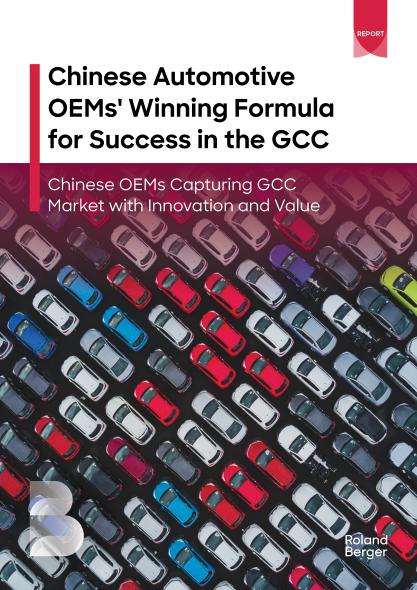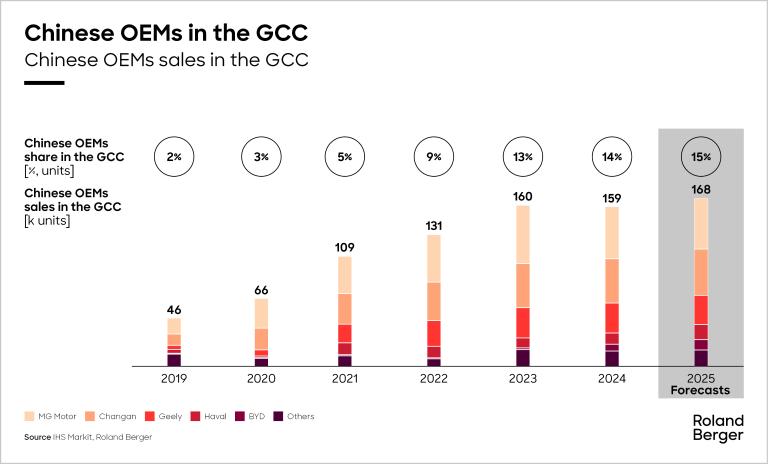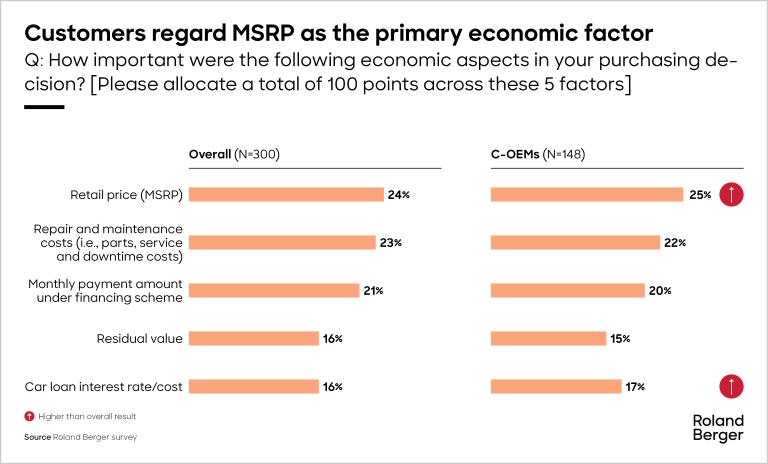Roland Berger advises companies on industrial goods and services, combining outstanding industry expertise and excellent technical know-how.


Chinese automotive OEMs' winning formula for success in the GCC
By Santiago Castillo and Arvind CJ
Chinese OEMs are capturing market share in the GCC with innovation, affordability, and strategic partnerships
Chinese automotive Original Equipment Manufacturers (OEMs) have rapidly emerged as key players in the Gulf Cooperation Council (GCC) region, reshaping the dynamics of the automotive industry. Brands such as MG, Geely, BYD, and Changan have become household names, recognized for their value-driven approach, innovative features, and partnerships with trusted local distributors.
Our comprehensive report, "Chinese Automotive OEMs' Success Formula for the GCC", offers deep insights into the strategic moves that have helped these brands thrive in the region. It highlights their rapid rise in market share, how they are winning over consumers, and what they need to do next to maintain their momentum.

Chinese OEMs: capturing market Sshare in the GCC
Chinese OEMs have steadily increased their market share in the GCC, growing from just 2% in 2019 to an estimated 15% by 2025. This growth is attributed to their keen understanding of the region’s unique automotive demands. The GCC market, which includes Saudi Arabia, the UAE, Kuwait, Qatar, Bahrain, and Oman, is ripe for disruption due to its growing demand for affordable, feature-rich vehicles, particularly in the SUV and sedan segments.
"Chinese OEMs are transforming the GCC automotive landscape, disrupting traditional market leaders."
Historically dominated by Japanese and Korean brands, the GCC automotive landscape is now seeing Chinese car brands as strong competitors. By focusing on cost-effective vehicles with advanced features, Chinese OEMs are meeting the demands of a growing middle-class and a younger, tech-savvy population. The report details how this approach has shifted the balance of power in the region’s car market.
What drives Chinese OEMs’ success in the GCC?
The report identifies several key factors behind the rise of Chinese automotive brands in the GCC:
1. Strong product-market fit
Chinese OEMs have tailored their offerings to match the GCC's consumer preferences, particularly focusing on SUVs, which account for a large portion of car sales in the region. These vehicles are designed to meet local needs for spacious, durable, and technologically advanced models. The youth demographic, with an affinity for modern features like smart technology and autonomous driving functions, has driven demand for feature-packed vehicles at accessible price points.
2. Competitive pricing
One of the standout factors is the ability of Chinese car manufacturers to offer premium features at highly competitive prices. For instance, models from brands like MG and Geely are often priced 25-30% lower than their Japanese and Korean counterparts, making them highly attractive to first-time buyers and budget-conscious consumers.
3. Innovation and technology
Chinese OEMs have focused heavily on incorporating the latest technology into their vehicles, providing features like autonomous parking, advanced safety systems, and connectivity options that appeal to tech-savvy drivers. This focus on innovation is not limited to traditional combustion engine cars but extends to electric vehicles (EVs), where Chinese brands like BYD and Xpeng are making significant strides.
4. Strategic partnerships with local distributors
To gain ground in the GCC, Chinese OEMs have partnered with well-established local distributors such as Al-Futtaim in the UAE and Abdul Latif Jameel in Saudi Arabia. These partnerships have provided them with critical market access, allowing them to leverage the expertise and infrastructure of trusted local players. The report underscores the importance of these relationships in ensuring smooth distribution, customer service, and financing options.
A favorable market environment for Chinese OEMs
The GCC is an ideal market for Chinese OEMs, thanks to several favorable factors, including:
- Growing disposable income: The region’s expanding middle class, with rising disposable incomes, has created a demand for affordable yet stylish and feature-rich vehicles.
- Regulatory support: The business-friendly environment in the GCC, with its low import tariffs and supportive regulatory framework for automotive companies, has further fueled the growth of Chinese brands.
- EV growth potential: As the region turns towards sustainable transportation, the demand for electric vehicles is increasing. Countries like the UAE aim to have 50% of their vehicles powered by electricity by 2050. Chinese OEMs, with their extensive EV offerings, are well-positioned to capture this growing market.
Areas of opportunity: What’s next for Chinese OEMs?
While Chinese OEMs have made impressive gains, the report highlights several areas where they can further strengthen their position in the market:
- Building stronger brand identities
Many consumers still perceive Chinese brands as a homogenous group offering similar vehicles. To stand out, Chinese OEMs need to focus on developing distinct brand personas. Each brand should have a clear identity that resonates with its target audience, whether through motorsports heritage, a commitment to sustainability, or cutting-edge technology. - Enhancing after-sales support
Long-term success depends on more than just making the sale. Chinese OEMs need to invest in building robust after-sales services, including parts availability, competitive service pricing, and enhanced customer support. Offering warranty programs and certified pre-owned vehicles can help boost consumer confidence and improve residual value. - Expanding EV offerings
As the demand for electric vehicles grows, Chinese OEMs have the chance to dominate the EV market in the GCC. By leveraging their technological expertise and partnerships with local distributors, they can drive the adoption of electric cars and position themselves as leaders in the region’s green mobility transition.
Implications for the GCC automotive industry
The rise of Chinese OEMs is transforming the GCC automotive landscape. Traditional automakers, such as Japanese and Korean brands, must adapt to this new competitive environment. For regional distributors, the report suggests exploring multi-brand strategies and capitalizing on synergies to engage customers across the product lifecycle. Additionally, regulators will need to keep pace with the adoption of EVs and Advanced Driver Assistance Systems (ADAS), ensuring the necessary infrastructure and legal frameworks are in place.
The GCC market offers tremendous growth opportunities for Chinese automotive OEMs. Their success so far is built on innovation, affordability, and a deep understanding of local consumer preferences. As they continue to refine their strategies and expand their offerings, Chinese car brands are poised to play an increasingly prominent role in the future of the GCC’s automotive sector.
For an in-depth look at the strategies driving this growth and the future of Chinese OEMs in the GCC, download the full report.
Register now to access the full report, delve into Chinese OEMs' success strategies in the GCC. Furthermore, you get regular news and updates directly in your inbox.








